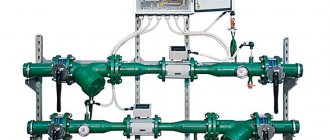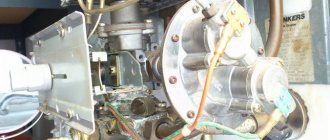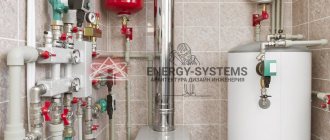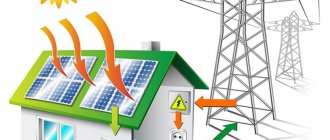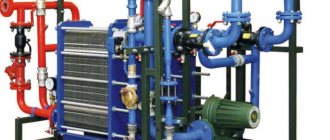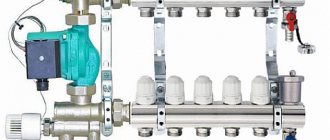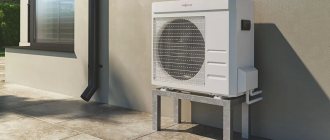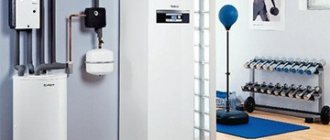Sometimes heating points are also called heating units. This is a somewhat outdated term, however, it also has a right to exist, since it quite accurately reflects the essence and purpose of the complex that connects the heating network with consumers, distributes coolant, sets and controls heat consumption modes.
Several decades ago, the concept of a thermal unit meant an installation located in a separate room and consisting of a pipeline, shut-off valves, measuring and control instruments (pressure gauges, thermometers) and mud collectors - special devices used to clean the coolant.
Over time, thermal power equipment has been improved, the requirements for it have increased, and new regulations and standards have been introduced. Today, what was previously called a heating unit is usually called an ITP or an individual heating point. Along with the term, the idea of its constituent elements has also changed.
A typical modern ITP includes the following units:
- input of heating network, water supply and power supply;
- adjusting heat supply and heat consumption parameters;
- accounting of thermal energy consumption, automation and instrumentation;
- connection of ventilation systems;
- connecting heating loads (systems);
- pumping, filtering and heat exchange equipment;
- energy-reserving devices of heating and ventilation systems.
Design of thermal units
Design of thermal units is one of the initial stages of construction. The development of a heating unit project is necessary for coordination with the heat supply organization. At this stage, the necessary calculations are made, equipment is selected, and the scope of installation work is determined.
A correctly and competently drawn up design of a heating unit allows you to calculate construction costs, avoid unjustified costs, and solve many problems during further operation. This process is described in more detail in the material designing heating points.
Our advantages:
- We carry out a full range of works on design, installation, maintenance of central and individual heating points!
- We have been installing and constructing ITP for more than 15 years!
- Own customer service - 24 hours;
- Warranty for work performed – 1 year;
- Availability of our own spare parts warehouse;
- Experienced specialists who have been trained by manufacturers and have appropriate certificates;
- Our company is the official authorized service center of the De Dietrich company, a service partner for the repair of BAXI, UNICAL, Viessmann boilers.
- We have a SRO certificate for this type of work;
- Employees have Rostechnadzor certification for industrial safety at gas distribution and gas consumption facilities and a third or fourth clearance group for electrical safety. They annually pass exams and receive permits to perform gas-hazardous work at ROSTEKHNADZOR.
Our specialists are ready to install, construct or reconstruct ITP and central heating substations of any complexity. The price is calculated individually for each object.
You can consult and agree on the cost of work by calling us by phone +7
Installation of thermal units
A modern heating unit is the most important element of a heating network, which is subject to the highest requirements. Proper installation of thermal units makes it possible to maintain their functionality for a long time and increase reliability.
Nowadays, in addition to the distribution function, thermal units monitor the consumption of thermal energy, so professional and high-quality installation of the ITP (heating unit) allows for uninterrupted and efficient operation of the equipment, and also ensures accurate accounting and saving of energy resources.
Individual heating point
ITP is needed to control the system inside one building or part of it. With the help of a heating unit, fuel is consumed more slowly, heat is distributed throughout the entire room or building evenly. Everything is arranged in such a way as to reduce the possibility of an accident to a minimum.
The heat metering unit can perform the following tasks:
- control and adjustment of parameters such as pressure, temperature, etc.;
- uniform distribution of coolant throughout all heat consumption systems;
- accounting for coolant consumption, as well as heat energy;
- stopping the heat supply (can be performed if necessary);
- ensuring protection of heat consumption systems from emergency situations with increasing coolant parameters.
This means that the output will be water at the required temperature. To ensure protection of the elevator unit from damage caused by large particles getting into the structure, which could easily damage the device, a mudguard is mounted in front of the unit.
Elevators have become very popular due to their reliability and stability during changes in thermal and hydraulic conditions of heating networks. Also, a big advantage of elevator units is that they can work autonomously, and the adjustment of the device is reduced only to choosing the nozzle diameter. The selection of the required nozzle, as well as pipes, can only be done by a design office that has the appropriate competencies.
Maintenance and repair of the heating unit
Maintenance of a heating unit (maintenance of ITP) is a set of measures that ensures uninterrupted operation of equipment, monitoring the functioning of units and elements of the facility during operation, carrying out seasonal and commissioning work, organizational and legal support of technical work, carrying out minor repair work, and checking instrumentation and control equipment.
All work on servicing heating units is carried out in accordance with current regulatory documents (PTE TE). Repair of thermal units with replacement of failed units is usually carried out by a specialized organization in accordance with an additional agreement.
Operating principle of ITP
The design of a heating point directly depends on the characteristics of the source supplying energy to the IHP, as well as on the characteristics of the consumers it serves. The most common type for this thermal installation is a closed hot water system with a heating system connected according to an independent circuit.
The operating principle of an individual heating point is as follows:
- Through the supply pipeline, the coolant enters the ITP, transfers heat to the heaters of the heating and hot water supply systems, and also enters the ventilation system.
- The coolant is then directed into the return pipeline and returned through the main network for reuse at the heat generating enterprise.
- Some volume of coolant may be consumed by consumers. To replenish losses at the heat source, CHP plants and boiler houses have make-up systems that use the water treatment systems of these enterprises as a heat source.
- Tap water entering the heating installation flows through the pumping equipment of the cold water supply system. Then some of its volume is delivered to consumers, the other is heated in the first stage hot water heater, after which it is sent to the hot water circulation circuit.
- Water in the circulation circuit moves in a circle through circulation pumping equipment for hot water supply from the heating point to consumers and back. At the same time, consumers withdraw water from the circuit as needed.
- As the fluid circulates along the circuit, it gradually releases its own heat. To maintain the coolant temperature at an optimal level, it is regularly heated in the second stage of the hot water heater.
- The heating system is also a closed loop through which the coolant moves with the help of circulation pumps from the heating point to consumers and back.
- During operation, coolant leaks may occur from the heating system circuit. The replenishment of losses is carried out by the IHP replenishment system, which uses primary heating networks as a heat source.
Cost of the heating unit project
The cost of designing a heating unit is usually determined individually in each specific case and depends on many factors: the type of heating unit being built; type of heating system; types, brands, types and quantities of equipment; the required power of the heating unit, volume and complexity of work and other indicators.
However, it is rightly noted that savings begin precisely at the stage of drawing up the project. With professional and high-quality design, the high price of modern, efficient equipment, the cost of the heating unit project, the cost of installation work and other expenses are recouped in the shortest possible time.
WHY DO THEY CHOOSE US?
Experienced company in the field of installation and repair of ITP
8 years of reputation, more than 300 completed orders
Carrying out work without intermediaries
Customized work procedure from design to installation and delivery to MOEK and Rostekhnadzor
Official guarantee for work
All products are in accordance with state regulations. standards
Strict adherence to deadlines
No additional costs other than those fixed in the estimate
Free consultation and estimate
A specialist will visit you for consultation and take measurements at a time convenient for you
The cost of installing a heating unit
The construction (installation) of a heating unit (heating station) consists of several stages.
- Installation, welding and plumbing work, including installation of fittings, pumps, heat exchangers, metering unit, laying pipelines.
- Electrical installation work - laying power cables, connecting electrical loads (metering, automation and control devices, pumps and other electrical equipment).
- Commissioning works.
- Commissioning of the heating unit.
The total cost of installation work depends on the volume of these operations.
Comprehensive information on the cost of installing a heating unit (point), its repair and other data can be found on the page “Cost of ITP”. Get an offer
Repair or modernization of a heat metering unit
- Work on completion, additional equipment, and modernization includes work caused by a change in the technological or service purpose of equipment, a building, structure or other object of depreciable fixed assets, increased loads and (or) other new qualities.
- Reconstruction includes the reconstruction of existing fixed assets, associated with the improvement of production and increasing its technical and economic indicators and carried out under the project for the reconstruction of fixed assets in order to increase production capacity, improve quality and change the range of products.
- Technical re-equipment includes a set of measures to improve the technical and economic indicators of fixed assets or their individual parts based on the introduction of advanced equipment and technology, mechanization and automation of production, modernization and replacement of obsolete and physically worn-out equipment with new, more productive ones.
However, there is no clear concept of repair in the legislation.
- According to paragraph 16 of the letter of the Goskomstat of Russia dated 04/09/2001 No. MS-1-23/1480 (hereinafter referred to as the letter of the Goskomstat), repair means work to maintain fixed assets in working condition during their useful life, which does not lead to an improvement in the original regulatory performance indicators .
- According to clause 14.2 of Art. 1 of the Town Planning Code of the Russian Federation (Civil Code of the Russian Federation), major repairs of capital construction projects (except for linear objects) include such work as: - replacement and (or) restoration of building structures of capital construction projects or elements of such structures, with the exception of load-bearing building structures; — replacement and (or) restoration of engineering support systems and networks of engineering support for capital construction projects or their elements; — replacement of individual elements of load-bearing building structures with similar or other elements that improve the performance of such structures and (or) restoration of these elements.
Fable
So, the owner of the heat energy source claims that he repaired the commercial heat metering unit, while changes were made to the design documentation and the work carried out was in the nature of modernization. The owner of the heat energy source claims that, according to the Rules for Commercial Accounting of Thermal Energy, approval of changes to the design documentation is not required. At the same time, at the unit for commercial metering of thermal energy, say, the type of heat meter was replaced, which led to a change in the formula for calculating thermal energy in accordance with the Methodology for commercial metering of thermal energy and coolant (Order of the Ministry of Construction No. 99/pr).
What really happened and what was required from the owner of the thermal energy source
For thermal energy and coolant metering devices, a short name has been adopted - heat meters.
The heat meter consists of two main functionally independent parts: a heat calculator (TV) and sensors (flow, temperature and pressure of the coolant).
A heat calculator is a specialized microprocessor device designed for processing signals (analog, pulse or digital - depending on the type of sensor used) from sensors, converting them into digital form, calculating the amount of thermal energy in accordance with the adopted algorithm (determined by the heat supply circuit), indicating and storage (archiving) of heat consumption parameters in the non-volatile memory of the device.
Requirements for design documentation are established by GOST 2.106-96 Unified System of Design Documentation (ESKD). Calculations must be performed in accordance with sections 10 and 13 of the ESKD. The procedure for making changes to design documentation is regulated by GOST R 21.1101-2013.
According to clause 7.1.2. GOST R21.1101-2013, a change to a document previously transferred to the customer is any correction, exclusion or addition of any data to it without changing the designation of this document. Changes to calculations are not permitted.
In accordance with paragraph 7.1.3 of GOST R21.1101-2013, if a change to a document is unacceptable, then a new document with a new designation must be issued.
Thus, the owner of the thermal energy source in the case under consideration had to release a new design for the metering system of the metering unit
And according to paragraph 38 of the Rules for commercial metering of thermal energy for a heat energy source, the design of a metering system for a metering unit is developed on the basis of a technical specification prepared by the owner of the thermal energy source and agreed upon with the adjacent heat supply (heating network) organization in terms of compliance with the requirements of the Rules for commercial metering of thermal energy, coolant, terms of the contract and conditions for connecting the heat source to the heat supply system.
Conclusion
That is, before upgrading the commercial heat energy metering unit, its owner was required to agree on the terms of reference with the adjacent heating network organization and agree on the design of the metering unit for compliance with the requirements of the Rules for commercial metering of heat energy and coolant.
How it works
The operating principle of the heating system control unit is very simple:
When the outside temperature drops, for example to -20 °C, the heating control unit supplies more heat to the rooms, thereby maintaining the indoor temperature at the required level, for example +20 °C.
And vice versa.
When the outside temperature rises, for example to +5 ° C, the weather control unit, as it is also called, supplies less heat to the premises.
Thus, heat consumption is reduced, and the temperature in the rooms remains at the level we need, for example, +20 ° C and does not increase to +28 ° C, as often happens during sudden warming.
The temperature does not rise to +28 °C
And scientifically speaking, the weather control unit is designed to ensure and maintain the required coolant temperature in the supply pipeline, depending on the outside air temperature.
